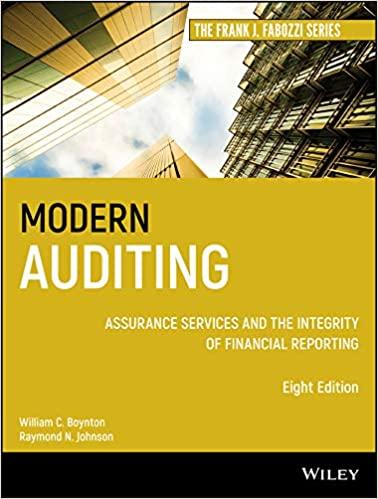Question
You have recently been employed by a large retail chain that sells sporting goods. One of your tasks is to help prepare periodic financial statements
You have recently been employed by a large retail chain that sells sporting goods. One of your tasks is to help prepare periodic financial statements for external distribution. The chain's largest creditor, National Savings & Loan, requires quarterly financial statements, and you are currently working on the statements for the three-month period ending June 30, 2000.
During the months of May and June, the company spent $1,200,000 on a large radio and TV advertising campaign. The $1,200,000 included the costs of producing the commercials as well as the radio and TV time purchased to run the commercials. All of the costs were charged to advertising expense. The companys chief financial officer (CFO) has asked you to prepare a June 30 adjusting entry to remove the costs from advertising expense and to set up an asset called prepaid advertising that will be expensed in July. The CFO explained that This advertising campaign has produced significant sales in May and June and I think it will continue to bring in customers through the month of July. By recording the ad costs as an asset, we can match the cost of the advertising with the additional July sales. Besides, if we expense the advertising in May and June, we will show an operating loss on our income statement for the quarter. The bank requires that we continue to show quarterly profits in order to maintain our loan in good standing.
Ethical codes are informative and helpful. However, the motivation to behave ethically must come from within oneself and not just from the fear of penalties for violating professional codes. Presented below is a sequence of steps that provide a framework for analyzing ethical issues. These steps can help you apply your own sense of right and wrong to ethical dilemmas:
Ethical codes are informative and helpful. However, the motivation to behave ethically must come from within oneself and not just from the fear of penalties for violating professional codes. Presented below is a sequence of steps that provide a framework for analyzing ethical issues. These steps can help you apply your own sense of right and wrong to ethical dilemmas:
| Step 1. | Determine the facts of the situation. This involves determining the who, what, where, when, and how. |
| Step 2. | Identify the ethical issue and the stakeholders. Stakeholders may include shareholders, creditors, management, employees, and the community. |
| Step 3. | Identify the values related to the situation. For example, in some situations confidentiality may be an important value that may conflict with the right to know. |
| Step 4. | Specify the alternative courses of action. |
| Step 5. | Evaluate the courses of action specified in step 4 in terms of their consistency with the values identified in step 3. This step may or may not lead to a suggested course of action. |
| Step 6. | Identify the consequences of each possible course of action. If step 5 does not provide a course of action, assess the consequences of each possible course of action for all of the stakeholders involved. |
| Step 7. | Make your decision and take any indicated action. |
Step by Step Solution
There are 3 Steps involved in it
Step: 1

Get Instant Access to Expert-Tailored Solutions
See step-by-step solutions with expert insights and AI powered tools for academic success
Step: 2

Step: 3

Ace Your Homework with AI
Get the answers you need in no time with our AI-driven, step-by-step assistance
Get Started


